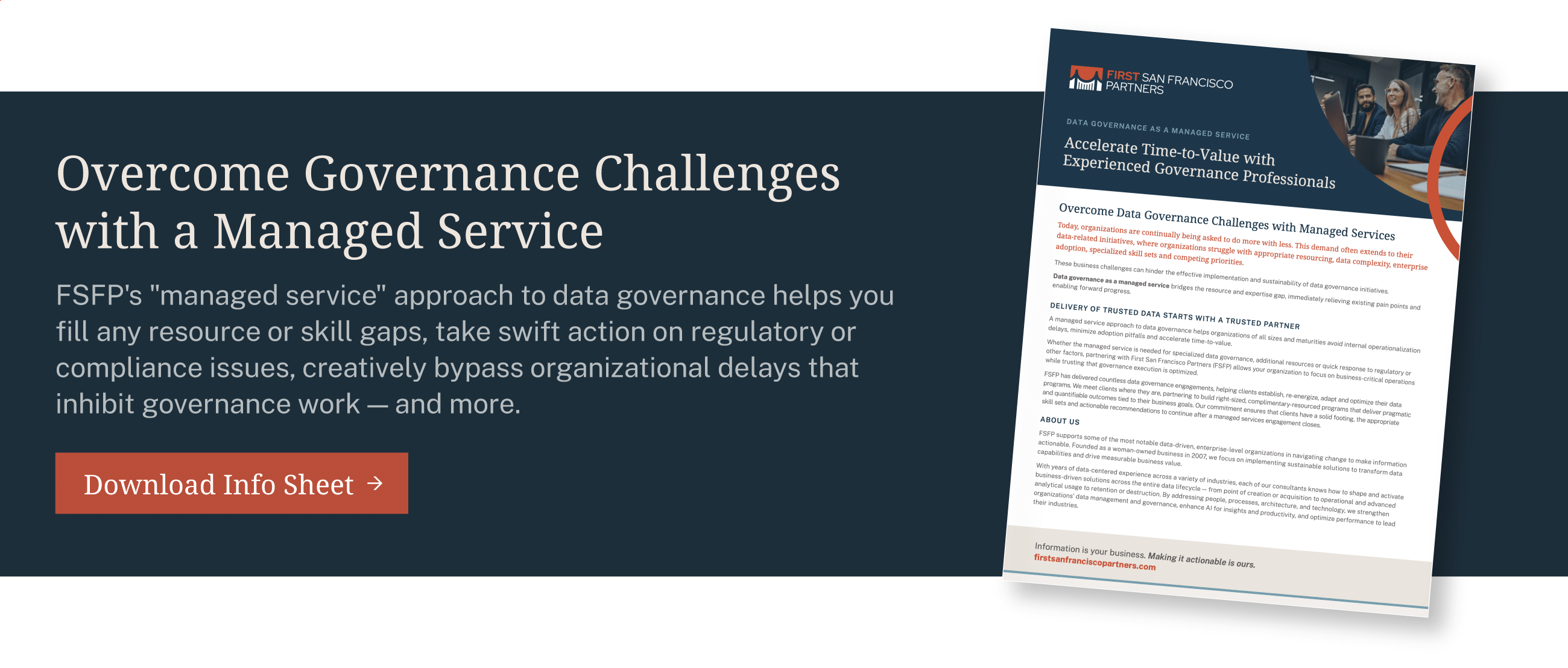Are you at the early stages of planning a Data Governance initiative at your company? Did you start implementing a governance program, only to see progress stall? If your Data Governance journey is not quite what you expected it to be, you can get back on track by following time-tested best practices — and sidestepping common pitfalls.
These are the top areas that I see plaguing companies in their pursuit of governing data, along with their best practices counterparts.
Governing Data from within IT
Often, the need for governance is first identified by the Information Technology (IT) organization. IT, however, is generally not the primary user of the data, nor are they the creator of it. In most cases, it’s the business side creating and using the data — and it’s the business users who must fix the data when errors are discovered, like duplicated or incomplete records.
Data Governance (DG) best practice: For optimal, lasting success in all things governance, the business side is best-positioned to manage the Data Governance program, with IT still being an important partner involved in the program.
Governing Data in Silos
When data issues arise within an individual business area or line of business, the tendency may be to address the issues within that unit. While a business unit-focused governance program may, indeed, satisfy the specific area’s internal governance needs, problems arise when — and because — data is shared across different business groups. When one group defines a given data element according to its own perspective and needs, another may define the same element differently which leads to inconsistent information across the company and the potential for even more problems.
DG best practice: Companies that are the most successful at governing their data make it an enterprise-wide effort by giving each business unit a seat at the DG table, along with specific accountabilities and responsibilities.
Assuming Everyone Understands (and Appreciates) the Value of Data
While some company stakeholders are highly involved in (or at least aware of) all that goes into creating data understanding, fixing data errors and appreciating quality data’s value, others may be immune to it. This is often because they only see clean, uniquely defined data and not the resources consumed to get it to that state — so they value it less.
When you assume everyone equally understands the value of company data, you make a dangerous assumption that people will be on board to do whatever it takes to improve data usage and quality. This is where communication and organizational change management comes in to play to help people understand the value of data and how to deal with changes that come up in the governance of data.
DG best practice: Governing data may be your passion or a key focus of your work group, but don’t assume others share the same enthusiasm. Work to effectively communicate governance’s importance to the organization in all you do, and your program will be much stronger for it.
Using Meaningless Metrics
Here’s a scenario that draws from the prior pitfall: A business unit declares a governance initiative a success, because it resulted in a 30% reduction in data errors. Another unit, unaware of the time and resources that typically go into fixing data issues — and the impact if they are not fixed — may view such a metric as useless (along with the investment made in the program).
Metrics have greater value if they are aligned to the interests of (or at least can make a connection with) stakeholders company-wide. Work to ensure there is a way of measuring how improvements to data (and its governance) are helping people progress toward their collective goals by translating the value statement into each area’s own language. Using the example above, it would be more meaningful to have extended the importance of the reduction in errors to the impact it provided, e.g., reducing the time it takes to process an order, thereby increasing customer satisfaction as well as order-to-cash efficiency.
DG best practice: To truly translate measurement into tangible business value, link progress metrics with impact metrics, aligning everything to company-wide business goals.
Treating Data Governance as a Project
Companies and teams are often project-focused. They identify a specific thing they want to accomplish, plan the approach, acquire approvals and/or funding and resources and plot out key milestones. Then they execute. There is a beginning, middle and end. When pursuing a Data Governance initiative, companies will often approach it as they would any project. It begins, then ends.
But with a project-focused mindset, governance programs typically fall apart. I’ve seen where, once the program is rolled out and allocated funding is used up, people often shift their focus to other projects. Or the established policies, practices and standards governing data reach a point where they are no longer maintained or adjusted in response to organizational and business changes.
DG best practice: Don’t treat governance as a project, because it creates the expectation of a finite timeline (with an endpoint) with finite funding and finite participation. Governance can’t be sustained without ongoing resources and support and a “we’re in this for the long-haul” mindset.



